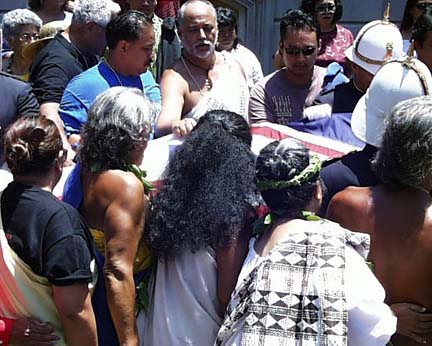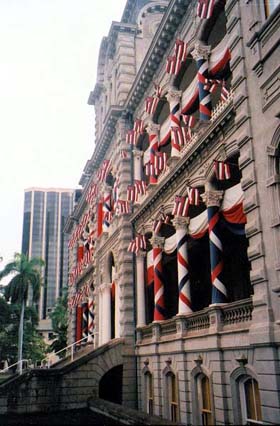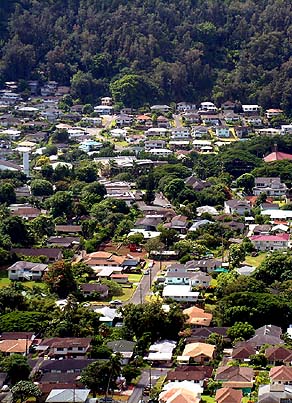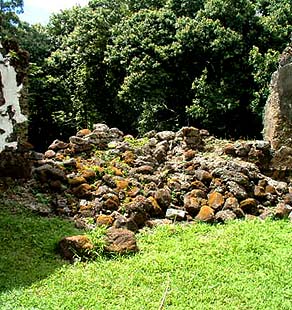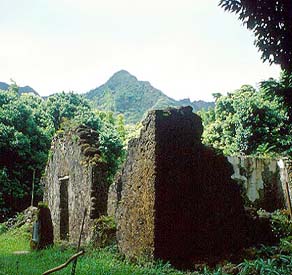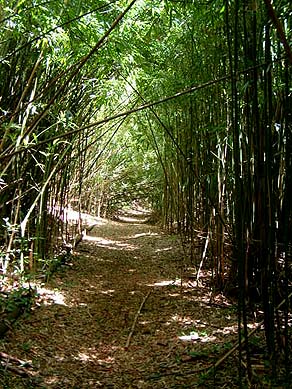 |
 |
 |
|||||||||||||||||||||
|
|
|
|
|
|
|
|
|
||||||||||||||||
|
|
|||||||||||||||||||||||
|
|
|
|
|
There are several community-based organizations working to preserve or restore the heritage of Nu‘uanu, whether environmental or cultural. In addition, there are important social and political groups who base their operations in Nu‘uanu. The traditional association of this valley with the Hawaiian Royalty, the overthrow of the Hawaiian monarchy, and the interplay between the royalty of old and issues concerning Hawaiian sovereignty today, have coalesced into this relationship between Nu‘uanu and various community groups. One such group is Hui Na‘auao, a sovereignty education group that took up residence in Nu‘uanu. Kalani explains:
|
||
|
|
||
|
"Many groups were out doing things about sovereignty. The Hui Na‘auao coalition was the first time it became formal, known for this purpose. And other groups came and said, 'We will join in this education effort, because we have been too disjointed, and together we can get more information out, we can get more research done, and it can be a strategic, combined effort.' "So even though we may disagree -- some may say, well, I want us to remain part of the US; another one may say, 'No way, I want to be a totally new country;' and everything in between, the spectrum -- we came to the table with this whole spectrum of opinion. We all agreed that it was important to have more people find out about sovereignty issues. "We had meetings for one year, learning to trust one another, bringing the various groups together so they could understand that we all had different points of view. And we could put them all together; we could come and talk."
|
|
|
|
"When the Hui Na‘auao formalized, they went looking for an office. It was decided that since we had so many group members with many people coming from the neighbor islands, we really needed a house to be able to house everyone. Also, meetings, and food, for Hawaiians go hand in hand: you have to feed your people, and gather and talk. So right off, we felt that we needed a house, and the group that set out to find one, found one in Nu‘uanu. I guess it’s very fitting. Nu‘uanu is a special area to so many people. "In that home, we met till past midnight, putting together education materials at different levels, and on different tracks of knowledge: for the one who didn’t know anything about sovereignty, to the one who is quite sophisticated and wanted to talk about treaties and so forth. So for almost three years, we met here in Nu‘uanu. "Dr. Kekuni Blaisdell, who's a leading voice in the sovereignty movement, lives in Nu‘uanu too, and he felt that it was always very fitting for us to be there, because of how noble Nu‘uanu is, this valley. He said, 'We’re here for a reason.'”
|
|
|
|
|
At the other end of the valley, a new group coalesced at Pohukaina and focused on the ali‘i. Lynette tells the story: "There is a group called Sacred Times, Sacred Places, and we started about six years ago, using the Palace grounds for gatherings because we knew that if we didn’t use it, somebody else would. We’d heard that the Governor wanted the Palace grounds to be used for more multi-cultural gatherings, which always says to us that eventually there would be no room. The message was that, multi-cultural is the way to go: let’s have Japanese, Chinese Portuguese, whatever. "But we are also aware that there are other sites for those groups to gather, elsewhere. All the other ethnicities in Hawai‘i have a lot of their cultural ceremonies in other places. But for Hawaiians, the Palace is the most significant place, and we wanted to make sure that we were the ones, as Hawaiians, who always had access to do whatever we needed to do there. That’s where our gatherings happen."
|
||
|
|
||
|
|
"As we found out more about Kamehameha III, and tried to figure out what was important about him, and what places in particular -- these were like sacred times, sacred places -- what places were specific to him, and who was taking care of them, and are those sites still around. Then we realized that connected to this mound was also Kamehameha III’s summer house, Kaniakapupu, which no one was taking care of. The connection is an ali‘i thing, you might say. In honoring our ali‘i, we wanted to be able to honor them all. "The Hawaiian Patriotic League is one organization that had just pushed back into public view the important role Kamehameha III had played in Hawaiian history. So they were with us when we went up to Kaniakapupu for this first visit. Everything was overgrown, it was very dark. And it was actually kind of eerie, but very beautiful, even in its falling-apart state."
|
|
"That was the first time we went up there and it was raining, and we agreed that not only would we go up there to try to take care of this place, we would open it up to everybody in that community." "Ten or fifteen years ago, someone came into our group and said, we’ve got to do something about Kaniakapupu," Kalani recalls. "None of the rest of us had been there, and I didn’t know it by name. That fellow was Clarence Ching, and he was the first one who brought it to my awareness by name." "But there was no money forthcoming," Lynette adds, "and that effort sort of fell apart. Looking at it in a larger context, this requires participation of more people than just us. And then we started going to things like neighborhood board meetings, in that area for Nu‘uanu, and just trying to find out what do people know about this? And we started to meet residents, folks who had been there forever."
|
|
|
|
"We got to learn more about the neighborhood, and those that are 'users' of the area. We got to meet about fifty or so bow hunters, who were really kind of neat. They also recognized that Kaniakapupu was kind of a sacred place, even though they were not Hawaiian necessarily. So we tried to form alliances with the various groups. We asked a bunch of them to come up to Kaniakapupu with us, and many people came, maybe about thirty or so, and we talked about what we could do, and what we envisioned. We worked with the archaeologist from the Bishop Museum, and from the University of Hawai‘i." "Now we have people coming up from Kua‘ana student services -- it’s a Hawaiian student retention and recruitment program at UH Manoa. They’ve been sending people, and the students really like to be up there. We give them a tour and a history of the area, and the rest of the time we are clearing back brush, or cutting weeds, pulling weeds, cutting the grass. We provide the tools."
|
|
|
|
|
"We hope to expand to include schools in the area. If we’re looking at what constitutes a community in terms of ahupua‘a, there are lots of groups in that ahupua‘a who can be resources, who can always come and learn. At some point we’re going to move into developing some kind of curriculum, some kind of material, that we can hand out as packets, and also some kind of calendaring system where we can invite people to come and participate in ceremony when we’re doing them.
|
||
|
|
||
"And we’re partnering up soon with the Board of Water Supply. They want to know how they can work with us. They’re going to have to build for themselves a new access road, and when they’re done with the pipes or whatever, we could still have use of it. Kupuna need to go up there. It’s a little too much of a hike for them to go up how we go up. So having a little access road means that we can bring kupuna in from the top, and it’s a short walk to where we have to go." "The Board of Water Supply has been very willing to partner with us. So we know that we can work with the people who are in government now to get the things that we need, because they actually see the sense of it all. Most people."
|
|
|
"Mel has tried his very hardest to make sure that we go through the proper protocol for the State. In other words, meeting with the people who can help us with permits, doing everything in a legal way, but it hasn’t been easy for some reason. There might be liability things that the State is afraid of. Or maybe they’re just afraid of us as Hawaiians. But it’s been an interesting process." "People tend to sort of dismiss us -- like we’re not even important. And yet, what we bring is our volunteerism, our time, our energy, out-of-pocket expenses for equipment; and whatever it is we do, we just do it. And I think that it’s a growing thing: its not going to get smaller, the effort is going to get bigger as we go along. So what that might be is an indication of the way that the community is going to be interacting with government hereafter, because government can’t do it. Their position is, 'We don’t have enough resources, we don’t have enough crew.' "
|
|
|
|
"That means nothing to us. If the responsibility has been given over to you, you cannot make excuses about why you cannot do it. What you should do is pass it on. And what we’re offering is to take on that responsibility."
Another responsibility is the environment itself. Stephen considers the relationship between culture and environment that might be possible in the replanting of Nu‘uanu.
|
||
|
|
||
| |
| |
|
|
 |
| Nu‘uanu Home | Map Library | Site Map | Hawaiian Islands Home | Pacific Worlds Home |
|
|
|||
| Copyright 2003 Pacific Worlds & Associates • Usage Policy • Webmaster |
|||
